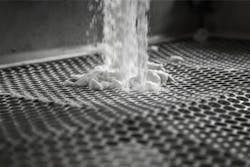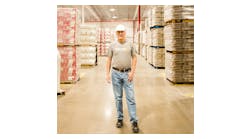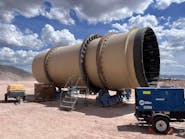Ways to achieve safe powder drying
The constant threat of dust fires and explosions is a concern to everyone working in the process industries. We do our best to contain dust inside process equipment; we see a little escaping here or there and clean it up; we find powder buildup on fittings and ledges. This dust, however, can be dispersed and raised to flammable concentrations, and with the presence of a source of ignition, disaster can result.
Dust cloud deflagrations (flash fires and explosions) occur when the following three components are present in one location concurrently:
- A combustible powder — with enough fine particles to form a cloud with a concentration above its minimum explosible concentration (MEC)
- A sufficient oxidant, which typically the oxygen in the air will provide
- An energetic ignition source
If a dust cloud deflagration begins in enclosed process equipment or inside a building, the explosion pressure that develops could be sufficient to rupture the equipment or destroy the building. This is a dust explosion.
An ignition source must be present for a dust explosion to start. Ignition sources can take many forms, but when powders are heated, subtle sources of ignition can present themselves that are associated with the heating process — and perhaps the inherent instability of the powder being dried. For example, powders in layer and bulk can sometimes self-heat, smolder and catch fire due to exothermic reaction (exothermic decomposition or exothermic oxidation) and sometimes applied heat can result in production of hot or incandescent particles, which can travel along conveying equipment and act as ignition source to dust clouds downstream. Time can also be a factor since some exothermic reactions take a while to get established. Industrial operations that are prone to fires and possibly explosions due to self-heating include powder drying/heating and its subsequent processing, handling, packaging, storage and transportation.
Typically, powder-drying operations involve the application of heat to a solution, wet powder or slurry. Bulking and packaging of the dried powder usually follows. Common dryer types include tray, fluidized bed, spray, rotary and vacuum dryers. In any type of dryer, the dry powder can build up as a bulk or layer in various locations within the dryer, or in downstream process equipment or ultimately in hoppers, silos, big bags or smaller packages.
Dry powder in bulk serves as a good thermal insulator, inhibiting cooling and promoting the generation and buildup of heat energy from its core. At a temperature often referred to as the onset temperature, an exothermic reaction process (self-heating) starts somewhere within the powder accumulation and can continue to grow, even if no more heat is applied to the powder from the dryer. Self-heating is a complicated phenomenon consisting of both an exothermic chemical reaction and a heat-transfer (heat-loss) process. In simple terms, when the rate of heat generation exceeds the rate of heat loss, temperatures can rise at an accelerating rate. If left unchecked, powder self-heating can result in smoldering, fire and sometimes explosion.
In some cases, temperature increase is not the only consequence of self-heating; some powders, when heated, exhibit exothermic decomposition with (rapid) evolution of large quantities of toxic or flammable gases giving rise to additional hazards to people and the business. And in the mildest cases of self-heating reactions, product quality can be compromised even if there is no smoldering or fire.
Note that the onset temperature for self-heating is not an intrinsic property of the powder. Factors such as powder composition, presence of impurities in the powder, geometry and size of the accumulated powder, air/oxygen availability and the duration of powder exposure to a given temperature can all affect the onset temperature of self-heating.
The systematic management of powder self-heating hazards requires a proper understanding of the thermal instability characteristics of the powders as well as identification of the locations or instances in the process where powders can undergo self-heating.
This article discusses some well-tried and tested methods for evaluating thermal instability properties of powders that take into account the actual conditions powders might experience in dryers and downstream equipment. The aim is to achieve safe powder drying in the interest of protecting operators, equipment, the community, product quality and the business.
Safe powder drying
Evaluation of self-heating hazards of powders1
The first step in ensuring safety from fires and explosions in drying operations is having a proper understanding of the thermal instability properties of the powder (including its potential for gas generation), dust cloud explosibility and gas flammability. This article focuses on the powder’s thermal instability hazards and any discussion of dust cloud explosibility and vapor flammability is beyond this article’s scope.
Powder self-heating hazards can occur when the temperature of the powder in bulk or layer is raised to a level at which the heat generation rate by the exothermic reaction exceeds the rate of heat lost to the surroundings. Temperature increase follows, which frequently results in smoldering and eventually fire. As previously mentioned, several factors can affect the onset temperature for self-heating. Other variables such as air flow through the bulk powder or over the powder surface also influence the transition from smoldering to glowing and flaming as well as the onset temperature for self-heating.
The effect of geometry is illustrated by understanding that the onset temperature for self-heating of a powder in bulk is expected to be lower than the same quantity of powder spread into a layer. This is because the surface area per unit mass, and therefore the rate of heat loss per unit mass will be lower for bulked powder. In simple terms, the powder in a layer is less insulated than a bulked powder.
For laboratory testing to provide usable indication of the hazards, the test sample must be representative not only of the powder in the process, but the laboratory tests must also reasonably simulate the conditions that the powder experiences during drying and subsequent downstream storage, packaging and transportation stages. Often a number of different tests may need to be considered to obtain all the necessary data for proper evaluation of the self-heating hazards during all process stages. This is particularly important if the initial screening test suggests an onset temperature for self-heating that is close to the drying temperature.
The results of the tests that will be discussed provide useful data to assess a powder’s potential for self-heating and to specify operating, storage, packaging and transportation conditions that will reduce the risk of self-heating.
Isothermal basket test2, 3
Measurement of exothermic activity involves heating the sample under controlled conditions to determine the point at which its temperature starts to increase independently of the external heat source.
Isothermal basket testing is performed by heating the powder samples in cubical wire baskets of varying sizes (typically three sizes) in an oven to determine the minimum temperature at which each sample size self-heats. This test allows one to observe the effect of scale (that is, powder size/quantity) on the powder’s onset temperature for self-heating more precisely. Each trial involves placing a stainless-steel mesh basket filled with the powder sample in an oven, which is heated and maintained at a preselected temperature until self-heating is detected or for a duration of 24 hours or longer depending on the actual heating or storage cycle under study, whichever occurs first. The trials are repeated at various temperatures and basket sizes until the sample’s minimum onset temperature for self-heating is determined for each basket size.
A plot of the onset temperature for self-heating as a function of basket dimensions will allow for the extrapolation to either the maximum safe
material temperature for a given-size container, or the maximum safe container size for a given material
temperature.
As can be imagined, the isothermal basket test has great advantages in flexibility and produces fundamental information with wide application. However, this method is time-consuming and therefore can be relatively expensive. The bulk powder test may offer a simpler option, although it has some limitations.
Bulk powder test4
A bulk powder test is used to evaluate self-heating properties of powder in quantities not exceeding 1 ton in situations when it is heated in bulk form. Examples include powder accumulations in bulk in some dryers, hoppers, silos or packaging.
A glass cylinder with a height of 80 mm and diameter of 50 mm, which is closed at the base by a sintered glass, is filled with the test powder and placed in a uniform temperature oven. The temperature of the oven as well as the powder temperature at four different heights within the glass cylinder is monitored.
Normally, a screening test is first performed during which the oven temperature is programmed to increase at a rate of 0.5°C/min (0.9°F/min) for a 14-hour period. If the results of the screening tests indicate a temperature difference higher than 50˚C (122˚F) between the onset temperature for self-heating and the dryer-operating temperature, hazardous exothermic reaction is unlikely to occur. However, additional testing will be required if any of the following conditions exist:
- The temperature difference between the onset temperature for self-heating and the dryer operating temperature is less than 50˚C (122˚F)
- The operating cycle is longer than the test period above the process temperature
- The onset temperature for self-heating is less than 200˚C (392°F)
If any of the above conditions exist, then an "isothermal" bulk powder test is conducted at 50˚C (122˚F) above the intended drying temperature for a duration longer than the maximum drying or heated storage time. Alternatively, an isothermal basket test may be conducted.
Aerated powder test4
The aerated powder test simulates conditions during drying (heating) operations of powder in quantities not exceeding 1 ton in which a hot air stream flows through the bulking powder — for example, in fluid bed drying.
The glass test cell used for this test is identical to the bulk powder test, however, in the aerated powder test, an air stream, which is at the same temperature as the oven temperature, flows at a rate of 0.6 1/min through the sample during the entire test cycle. As in the bulk powder test, the sample temperature is measured at several locations in the cell to detect any exothermic activity and the activity’s onset temperature.
Similar to the bulk powder test, normally a screening test is first performed during which the oven temperature is programmed to increase at a rate of 0.5°C/min (0.9°F/min) for a 14-hour period. If the results of the screening test indicate a temperature difference higher than 50˚C (122˚F) between the onset temperature for self-heating and the dryer-operating temperature, hazardous exothermic reaction is unlikely to occur. Additional testing will be required, however, if any of the following conditions exist:
- The temperature difference between the onset temperature for self-heating and the dryer-operating temperature is less than 50˚C (122˚F)
- The operating cycle is longer than the test period above the process temperature
- The onset temperature for self-heating is less than 200˚C (392°F)
If any of the above conditions exist, then an "isothermal" aerated powder test is conducted at 50˚C (122˚F) above the intended drying temperature for a duration longer than the maximum drying or heated storage time.
Note that the aerated powder test is not intended to simulate the fluidization condition, which might actually remove decomposition heat due to high airflow. Instead, the test simply increases aeration beyond that expected from natural air diffusion alone. Ideally, the test provides a reasonable worst-case simulation of drying conditions at the end of a fluid bed drying cycle, when less heat is removed (that is, when the dryer fan is off but induced airflow is still present).
Powder layer test4
The powder layer test (also called air-over-layer test) simulates the conditions in which hot air passes above a layer or deposit of powder in a dryer. Examples include tray dryers and powder deposits on the internal surfaces of all dryer types.
A metal tray with dimensions 75 mm by 40 mm and 15 mm deep (3 inches by 1.6 inches by 0.6 inches) is filled with the test powder and heated by air passing around the tray (and powder) at a velocity of 4.3 m/min (14 ft/min). Temperature is monitored by thermocouples in the powder bed and around the outside of the tray.
Similar to the bulk powder and aerated tests, normally a screening test is first performed during which the air temperature is programmed to increase at a rate of 0.5°C/min (0.9°F/min) over a temperature range of 20˚C to 400˚C (68 ˚F to 752˚F) for a 14-hour period. If the results of the screening tests indicate a temperature difference higher than 50˚C (122˚F) between the onset temperature for self-heating and the dryer operating temperature, hazardous exothermic reaction is unlikely to occur. However, additional testing will be required if any of the following
conditions exist:
- The temperature difference between the onset temperature for self-heating and the dryer operating temperature is less than 50˚C (122˚F)
- The operating cycle is longer than the test period above the process temperature
- The onset temperature for self-heating is less than 200˚C (392°F)
If any of the above conditions exist, then an "isothermal" powder layer test is conducted at 50˚C (122˚F) above the intended drying temperature for a duration longer than the maximum drying or heated storage time.
Conclusion
Powders in layer and bulk can smolder and catch on fire by a process of self-heating due to exothermic reaction (exothermic decomposition or exothermic oxidation). Powder self-heating occurs when the powder temperature is raised to a level at which the heat liberated by the exothermic reaction exceeds the heat lost to surroundings. This can result in a runaway increase in temperature.
Preventing thermal runaway and subsequent fires and explosions in drying operations requires proper understanding of the thermal instability properties of the powder through specific and tailored laboratory tests.
For laboratory testing to provide usable indication of the hazards, not only the test sample must be representative of the powder in the process, but the laboratory tests must also reasonably simulate the conditions experienced by the powder during the drying and subsequent downstream storage, packaging and transportation stages.
Precautions for avoiding smoldering, fires and explosions include:
- Keeping the powder temperature at a safe margin below the temperature for the onset for self-heating obtained by appropriate test methods
- Facility and equipment design should avoid ledges, corners, dead zone, etc., where powder could inadvertently build up inside process equipment
- Avoid accumulation of hazardous levels of powder deposits on the inside surfaces of process equipment
The prevention of thermal runaway in drying operations can be achieved through careful application of the tests described in this article; they form an important route to achieving safe powder drying. Of course, fire and explosion protection measures and measures to avoid other sources of ignition must also be examined through good process safety practices to achieve safe plant operation.
References
- John Abbott, "Prevention of Fires and Explosions in Dryers", 2nd Edition, The Institution of Chemical Engineers, 1990.
- P. C. Bowes, "Self-Heating: Evaluating and Controlling the Hazards," Building Research Establishment, HMSO.
- P. F. Beever and P. F. Thorne, "Isothermal Methods for Assessing Combustible Powders – Theoretical and Experimental Approach," Symposium Series No. 68, Institution of Chemical Engineers, 1981.
- N. Gibson, D. J. Harper, and R. L. Rogers, "Evaluation of the fire and explosion risk in drying powders," Plant/Operations Progress, Vol. 4, No. 3, July 1985, pages 181–189.
Vahid Ebadat, Ph.D., M.Inst.P, MIEE, C.Phys., is CEO of Stonehouse Process Safety Inc. He has worked extensively as a process and operational hazards consultant for the chemical, pharmaceutical, food, oil and gas, and paper and wood industries. Ebadat has published many technical articles and papers globally and speaks widely on the topics of process safety, dust explosion mitigation, gas and vapor flammability and controlling electrostatic hazards. For more information, call 609-455-0001 or email [email protected].


